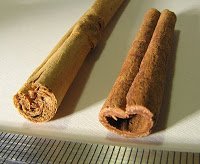SifuPhil
R.I.P. With Us In Spirit Only
- Location
- Pennsylvania, USA
Cinnamon, that sweet spice that is made from the bark of the cinnamon tree and found in most people's kitchen cabinets, is used for many cooking chores from making breads and muffins to teas and desserts. It's one of the first spices that come to mind when we think of Mom's old-time cooking, and has been a staple on the spice rack for centuries.
Unfortunately, there's a 95% chance that what you're using isn't really cinnamon.

Cassia is a "cousin" to the cinnamon tree and is the most-often used spice under the "Cinnamon" name. In the picture of cinnamon sticks above, true cinnamon (usually from Ceylon) is seen on the left. The layers are paper-like and fragile, breaking easily by hand and rolled in multiple layers.
On the right is Cassia, rolled into a much thicker tube with only one layer. It is much harder to break with the hands.
There are proponents of each specie of cinnamon - cassia tends to be sweeter while true cinnamon has a deeper, more complex and flavorful taste.
What true cinnamon and cassia do not have in common is their coumarin content. Coumarins are naturally occurring plant components that can have strong anticoagulant properties. Because our blood needs to maintain its ability to coagulate in times of injury, excessive intake of coumarins over a prolonged period of time can pose health risks. While the level of naturally occurring coumarins in Ceylon cinnamon appears to be very small and lower than the amount that could cause health risks, the level of naturally occurring coumarins in the cassia cinnamons appears to be higher and may pose a risk to some individuals if consumed in substantial amounts on a regular basis. For this reason, organizations like the Federal Institute for Risk Assessment in Berlin, Germany have recommended that large amounts of the cassia cinnamons be avoided.
Cassia itself is graded at several levels according to its purity, and as with most foodstuffs the more you pay the better quality you'll get. As for Ceylon cinnamon, if you really want it you can find it, but be prepared to pay a premium for it.
Unfortunately, there's a 95% chance that what you're using isn't really cinnamon.

Cassia is a "cousin" to the cinnamon tree and is the most-often used spice under the "Cinnamon" name. In the picture of cinnamon sticks above, true cinnamon (usually from Ceylon) is seen on the left. The layers are paper-like and fragile, breaking easily by hand and rolled in multiple layers.
On the right is Cassia, rolled into a much thicker tube with only one layer. It is much harder to break with the hands.
There are proponents of each specie of cinnamon - cassia tends to be sweeter while true cinnamon has a deeper, more complex and flavorful taste.
What true cinnamon and cassia do not have in common is their coumarin content. Coumarins are naturally occurring plant components that can have strong anticoagulant properties. Because our blood needs to maintain its ability to coagulate in times of injury, excessive intake of coumarins over a prolonged period of time can pose health risks. While the level of naturally occurring coumarins in Ceylon cinnamon appears to be very small and lower than the amount that could cause health risks, the level of naturally occurring coumarins in the cassia cinnamons appears to be higher and may pose a risk to some individuals if consumed in substantial amounts on a regular basis. For this reason, organizations like the Federal Institute for Risk Assessment in Berlin, Germany have recommended that large amounts of the cassia cinnamons be avoided.
Cassia itself is graded at several levels according to its purity, and as with most foodstuffs the more you pay the better quality you'll get. As for Ceylon cinnamon, if you really want it you can find it, but be prepared to pay a premium for it.

